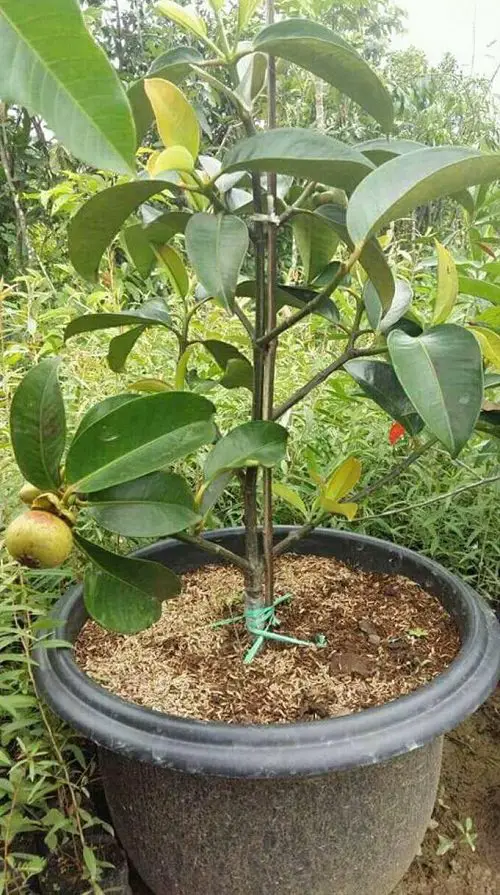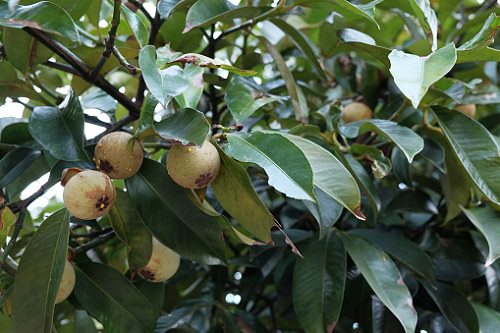Bearing exotic fruits, a mangosteen tree can be a great addition to your garden. Learn everything on How to Grow Mangosteen Tree here!
Mangosteen is a tropical fruit, mostly found in a frozen form in most of the supermarkets. It is rarely available fresh. You can grow it in a warm, humid environment with a temperature range of 68-86 F (20-30 C). Learn more about How to Grow Mangosteen Tree and its planting requirements in the below article.
Botanical Name: Garcinia mangostana
Height: 20-70 feet
What is Mangosteen?

Mangosteen grows mainly in Thailand, Vietnam, Burma, Southwestern India, and the Philippines. The origin of this tropical fruiting tree is unknown, but as per speculations, it has its roots from the Sunda Islands and the Moluccas.
The slow-growing, upright, and pyramid-shaped tree produces black, flaky outer bark that contains bitter latex inside. The fruits are round, having a purple-red hue, with 1-3 inch diameter. They have a juicy, sweet, and tangy flavor. The soft snow-white flesh has slightly acidic, luscious taste. It is also famously known as the ‘queen of tropical fruits.’
How to Grow Mangosteen Fruit Trees?
Climate
Being a hot climate tree, it cannot bear temperatures below 40 F (4 C) and may face difficulty above 100 F (37 C). It needs high humid conditions and a good rainfall to survive well.
Propagation
From Seeds
- Choose firm and moist seeds from the ripened mangosteen fruit with a white to off-white center.
- Soak the seeds in water for 24 hours before planting.
- Sow them 1-inch deep in garden soil.
- They will germinate in 18-24 days.
- Protect the seedlings from winds and extreme temperature fluctuations.
- As mangosteen is a very slow-growing plant, young plants will require two years to reach 12-18 inches height.
Note: Mangosteen plants do not respond well to re-planting. Planting the seeds directly in the ground is a great way to start the tree. You can also grow it in a biodegradable pot with organically rich, and sandy soil.
To save time, you can also buy a well-grown plant from a nursery and directly plant it in your garden. This will save you 2-3 years that the plant takes when starting from seed.
Requirements for Growing Mangosteen Tree

Location
Being a tropical plant, it enjoys direct and filtered light, both. A spot that gets a minimum of 5-6 hours of direct sunlight a day, with shaded afternoons, will be ideal for its optimum growth.
Soil
The tree does well in rich, porous, and well-draining soil. Clay soil with equal parts of sand and silt works best. Mangosteen is going to do even better in soil with a slightly acidic pH.
Water
Water the plant regularly in the initial stage for best growth. During dry spells, young plants will require consistent watering to keep the soil moist. be careful about not to overwater the plant as it may not survive in standing water and die. Once the tree attains a good growth, you don’t have to care much as it’ll be self-sufficient then.
Mangosteen Care
Fertilizer
Feed the plant with a 20-20-20 or 20-15-20 fertilizer once every 4-5 months. Continue fertilization until the tree turns 3-4 years old. If you are looking forward to organic fruits, you can use just the manure too. Alternatively, you can side dress the plant with fish emulsion. Once the tree establishes itself, you don’t have to feed it anymore.
Pests and diseases
The bark of the mangosteen contains bitter latex, hence pests and diseases rarely affect the tree. Still, look out for leaf-eating caterpillar. They can be handpicked and squashed.
Harvesting and Storage

Mangosteen tree begins to bear fruits after 7-9 years. The fruit ripens in summer. Harvest when the skin turns dark red or purple from greenish-brown and the fruit forms 4-8 triangle rosettes on top. Handpicking is a good method for harvesting.
You can store mangosteen for up to 20 to 25 days in a dry and warm environment. Avoid refrigerating as it hampers the taste.
Uses of Mangosteen Fruit
- They taste best when eaten fresh and raw.
- The fruits are also canned and used for making jams.
- Seeds are also eaten roasted.
- The rind is a rich source of protein and used to make jellies after treating with 6% sodium chloride to eliminate astringency.
Other Uses
- The twigs of the tree are have uses as chewsticks in Ghana.
- High in catechin, tannin, and rosin, the rind is also used to tan leather in China.
- The wood of the tree is famous for the construction and cabinetwork.
- The fruits also have medicinal uses. The powdered rind is used to overcome dysentery, eczema, and other skin disorders.



Hi, I have a mangosteen about 5 feet high-it was raised about 3 feet in a nursery and I have had it for some years. I transferred it from a large planter into the ground, gave it shade saran cover. After transplant she looked pretty good for 3-4 weeks even though I had transferred her bare root. But of a sudden rusty looking spots started on the leaf bottoms, and the leaves started to brown and die. The local ag station gave me the name Ferbam fungicide to treat it. Do you concur?